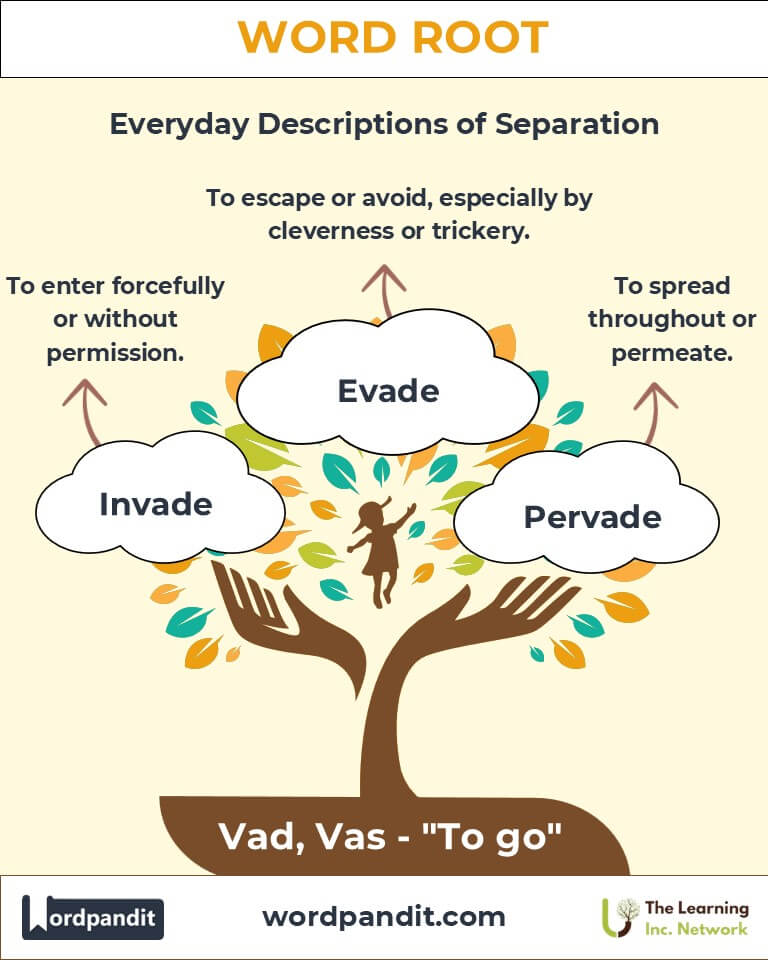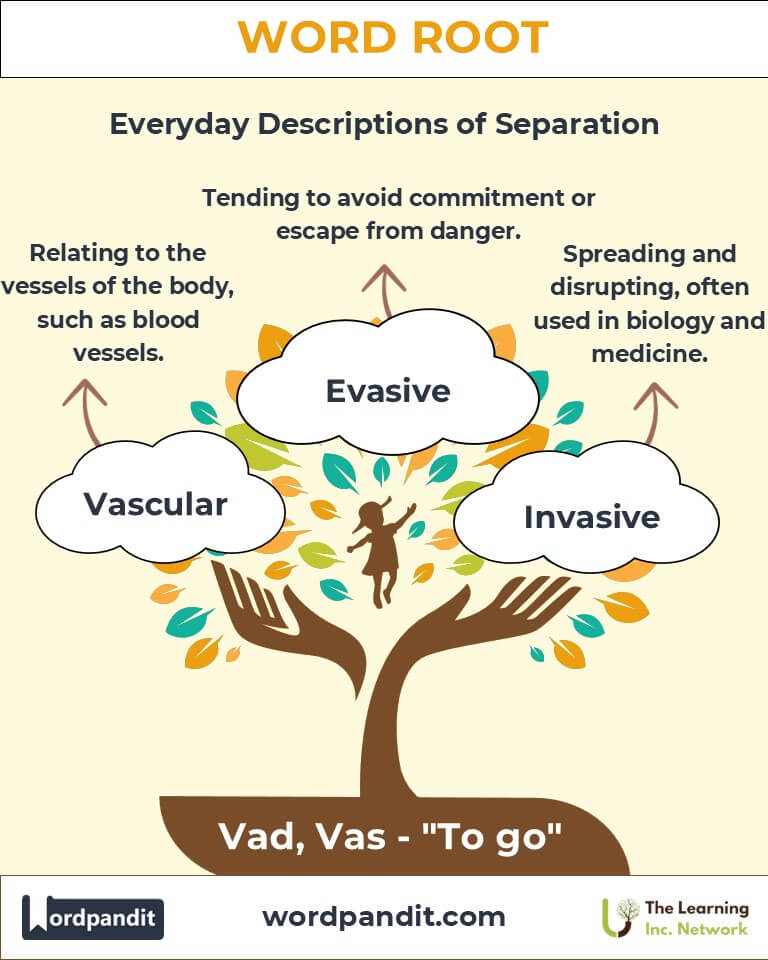Vad, Vas: The Dynamic Root of Motion and Travel
Discover the linguistic journey of "vad" and "vas," roots derived from Latin, meaning "to go." From the bold conquests of "invade" to the subtle escapes of "evasive," this root captures the essence of movement, exploration, and progress in language and life.

Table of Contents
- Introduction: The Essence of "Vad" and "Vas"
- Etymology and Historical Journey
- Mnemonic: Unlocking the Power of "Vad" and "Vas"
- Common "Vad" and "Vas"-Related Terms
- "Vad" and "Vas" Through Time
- "Vad" and "Vas" in Specialized Fields
- Illustrative Story: "Vad" and "Vas" in Action
- Cultural Significance of the "Vad" and "Vas" Roots
- The "Vad" and "Vas" Family Tree
- FAQs About the "Vad" and "Vas" Word Root
- Test Your Knowledge: "Vad" and "Vas" Word Root Quiz
- Conclusion: The Legacy of "Vad" and "Vas"
Introduction: The Essence of "Vad" and "Vas"
Imagine paths untrodden and journeys undertaken—the roots "vad" and "vas," from the Latin verbs vadere ("to go"), evoke the imagery of movement and change. Pronounced "vahd" and "vahs," these roots permeate words that describe both bold advances and subtle evasions. Their versatility makes them central to expressions of action and motion, found in literature, technology, and everyday conversation.

Etymology and Historical Journey
The roots "vad" and "vas" derive from the Latin vadere, meaning "to go" or "to proceed." Early Latin texts employed these roots to depict travel, invasions, and movements both physical and metaphorical. With the Roman Empire's expansion, "vad" and "vas" entered Romance languages, branching into English during the Middle Ages, enriching the vocabulary of motion and progression.
Mnemonic: Unlocking the Power of "Vad" and "Vas"
To remember "vad" and "vas," visualize a bold knight (vad) charging into battle, and a cunning fox (vas) slinking away unseen. Together, they represent the dualities of motion—advancing and retreating.
Mnemonic Device: "Vad advances boldly, Vas vanishes subtly."
Common "Vad" and "Vas"-Related Terms
- Invade (in-vayd): To enter forcefully or without permission.
Example: "The army planned to invade the neighboring kingdom at dawn." - Evasive (ee-vay-siv): Tending to avoid commitment or escape from danger.
Example: "Her evasive answers raised suspicions during the interrogation." - Pervade (per-vayd): To spread throughout or permeate.
Example: "The scent of jasmine pervaded the summer air." - Evade (ee-vayd): To escape or avoid, especially by cleverness or trickery.
Example: "He managed to evade capture by hiding in the dense forest." - Vascular (vas-kyoo-lar): Relating to the vessels of the body, such as blood vessels.
Example: "The surgeon focused on repairing the damaged vascular tissue."
"Vad" and "Vas" Through Time
- Invade: Initially used in military contexts, it now applies to any forceful or unwelcome entry, such as a virus invading a body.
- Evade: Its meaning has broadened from physical escape to include avoiding responsibilities or questions, reflecting social and psychological dynamics.
"Vad" and "Vas" in Specialized Fields
- Medicine: Vascular describes blood vessels crucial for circulatory health.
Example: "Vascular diseases often require early intervention." - Biology: Invasive Species are organisms that spread and disrupt ecosystems.
Example: "The invasive plant species threatened native vegetation." - Law: Evade refers to avoiding taxes or legal obligations.
Example: "The company was penalized for attempting to evade taxes."
Illustrative Story: "Vad" and "Vas" in Action
In a bustling city, Ava, an investigative journalist, sought to uncover corruption. Her bold investigations (vadere) often led her into danger. When confronted by adversaries, her quick thinking and evasive maneuvers (vas) ensured her safety. Ava’s journey symbolized the power of action and discretion in overcoming challenges.
Cultural Significance of the "Vad" and "Vas" Roots
The duality of "vad" and "vas" mirrors cultural narratives of heroism and cunning. Myths and legends frequently highlight bold advances into the unknown and clever retreats from peril. In modern times, these roots resonate in contexts ranging from technological innovation to personal growth.

The "Vad" and "Vas" Family Tree
- Ven/Vent (to come):
Example: Advent (the arrival of an important event), Convention (a coming together for a common purpose). - Grad (to step):
Example: Graduate (to move to a higher level), Gradual (proceeding step by step). - Port (to carry):
Example: Transport (to carry across), Import (to bring in goods or services).

FAQs About " Vac "
Q: What do "vad" and "vas" mean, and where do they come from?
A: The roots "vad" and "vas" come from the Latin word vadere, meaning "to go" or "to proceed." These roots appear in words that describe motion or progression, such as "invade" (to go into) or "evasive" (to avoid by moving cleverly).
Q: How are "vad" and "vas" used differently in words?
A: Both "vad" and "vas" signify motion, but their usage often depends on the word's structure or language evolution. For example, "invade" uses "vad" directly, while "evasive" transforms "vas" into a descriptive adjective.
Q: Why does "evasive" have a connection to avoiding danger?
A: "Evasive" originates from the Latin evasivus, rooted in evadere (to escape). It refers to the act of avoiding danger or commitment by clever or indirect means, emphasizing a subtle form of motion.
Q: What is the difference between "pervade" and "invade"?
A: Both involve motion, but "pervade" focuses on spreading throughout something completely, derived from per- (through) and vadere (to go). "Invade" is more forceful and specific, implying an entry into a defined space.
Q: Why is "vascular" connected to the root "vas"?
A: "Vascular" pertains to vessels in the body, such as blood vessels. These vessels act as pathways for motion—circulating blood, nutrients, or oxygen—making the connection to "vas" (to go) clear.
Test Your Knowledge: " Vac " Mastery Quiz
1. What does "vadere" mean?
2. Which word means "to enter forcefully"?
3. What describes "spreading throughout"?
4. Which term is used in biology for non-native species?
5. What does "evasive" mean?
Conclusion: The Legacy of "Vad" and "Vas"
The roots "vad" and "vas" embody the timeless themes of action and adaptation. Whether describing bold conquests or subtle escapes, their linguistic richness highlights humanity’s eternal dance with motion and progress. Let "vad" and "vas" inspire you to explore paths untaken and navigate challenges with grace.












